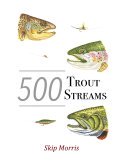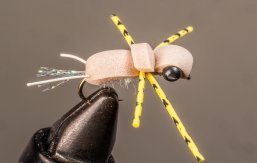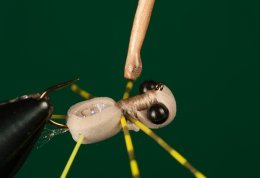Bass Back in the Salad
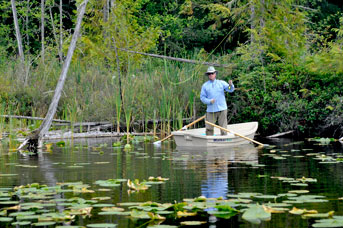 Bass back in the salad—the author casts his bass bug among lily pads
Bass back in the salad—the author casts his bass bug among lily pads
and fallen trees—that’s where the fishing is trickiest but the bass are often most abundant.
Learning the Tricks for Catching Largemouth Bass
I remember my first time fly fishing for largemouth bass, back in my mid teens, as...tricky.
Frustrating too. Tangled milfoil grew in mats along the edges of the little lake and brush and tree branches hovered just above much of that.
So I tossed my cork popper within inches of the greenery and limbs and tried to draw the bass out with a teasing retrieve of the fly.
I did okay.
Sometimes there was a channel cutting into the lake plants and that was particularly good. But I knew there were far more bass back in the salad than the relative few I was pestering along its outer edges.
Snag Guards: Too Good to be True?
Some time later I read about the monofilament snag guard, looping just outside the hook’s point.
It was a revelation.
I can’t recall if I first tied a fly with a snag guard or purchased a fly already carrying one, but I do remember inspecting the clear, thick, strand, squeezing it down and feeling its stiff resistance, and deciding it must surely protect the fly from snags...and bass.
I really couldn’t imagine the thing letting me hook a fish.
Still, I’d seen the snag guard endorsed in print several times, and I was anxious to reach back into the weeds after all those bass that taunted me, all those bass back in the salad.
Tips for Successful Fishing with a Snag Guard
It took me a while to get the hang of it, but I eventually learned to
- tease the fly lightly over a lily pad or a log
- drop the rod-tip
- grip the line
- rear back when a bass took
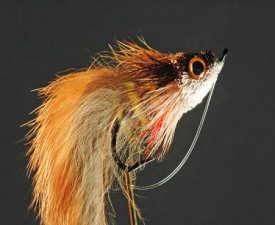 That heavy monofilament curving around the
That heavy monofilament curving around the
hook’s point is a snag guard—the snag guard
revolutionized bass fly fishing and is
critical for those bass back in the salad.
So, your first order of business for tackling largemouth bass back in the salad is to tie your floating and diving largemouth-bass flies with snag guards, or buy them that way.
You can always cut a snag guard off if you don’t need it, but there’s no way I know to add one out on the water when you do need it.
No doubt part of my problem long ago with accepting the snag-guard and tossing my snag-guard flies back to the bass back in the salad was,
I knew trout, not bass.
Trout vs. Bass: Big Differences When You Fish with a Fly
Even by the age of 13 I’d spent a lot of hours on trout streams and lakes. If you’re a trout fly fisher, even a good one—perhaps especially if you’re a good one—you’ll have to let go of many precepts about even the most essential principles of fishing a fly if you’re going to succeed with bass.
The Importance of Cover
Largemouth bass are cautious in the shallows—they know they’re exposing themselves to predators there. But that risk never seems to deter them—bass spend a lot of time in water from four feet deep to so shallow it barely covers their dorsal fins.
All they require in order to visit the shallows is overhead or side cover.
Overhead Cover vs. Side Cover
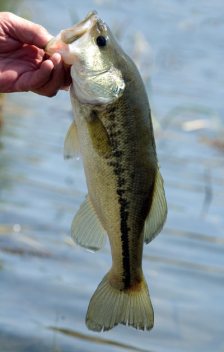 A good largemouth Skip hooked in and then
A good largemouth Skip hooked in and then
hauled out of reeds and a tangle of milfoil.
Typical for bass back in the salad.
Overhead cover includes not just water-plants such as lily pads, but fallen timber and brush, docks, even anchored boats.
Side cover is anything a bass can hold next to and sort of blend with, or dart behind. Flooded timber in reservoirs, boulders, and pilings left from old docks all make good side cover.
Overhead cover in particular calls for tactics that keep bugs from snagging.
Stumped? Try Floating Hair Bugs or Poppers
Most fishing in heavy bass cover is about floating hair bugs and poppers. They’re typically easier to fish in cover than sinking flies because the strike is visual—with sinking flies the strike must be felt, and that’s tricky when the line is dragging across vegetation or wood.
I no longer hesitate to toss my hair bugs back over logs or among lily pads or anything else that might hide a bass.
But I’m always thinking as I’m retrieving the fly.
I try to avoid that “V”-shaped indentation in a lily pad—once a bug goes up that “V,” a snag is almost inevitable, snag guard or no.
Over branches and logs I work the bug with particular care and patience as these are also likely places for it to snag—but when my packed-hair fly drops on the near side of a floating log and a bass that’s been stalking it slams it down, I figure the reward is well worth my efforts. And for bass back in the salad, this is a classic scenario.
Flies that Sink
It’s common to throw sinking flies back into brush or weeds too, but many sinking bass flies have a twist that floating bass flies lack: they ride upside down.
Usually it’s metal barbell eyes mounted atop their shanks that make these flies flip over (the Clouser Minnow, for example). But increasingly it’s the use of jig hooks (as is the Grim Reaper) that insures the flip—jig hooks include sharp bends in their shanks up near their eyes that really raise their centers of gravity.
An inverted fly tends to avoid snags, but in the thick stuff that largemouth like, it may not be enough, so even flies that flip over are sometimes tied with snag guards.
But where the obstacles are spread out a bit,
a snag guard may not be required...
unlike floating flies for bass back in the salad.
This snag-guard matter also depends on how carefully you work a sinking fly.
You can:
- strategically work the rod tip side to side,
- speed or slow the retrieve, and perhaps avoid snagging in serious weeds with no snag guard.
This is a real challenge, though, with sinking flies as you can’t really see what’s down there to avoid.
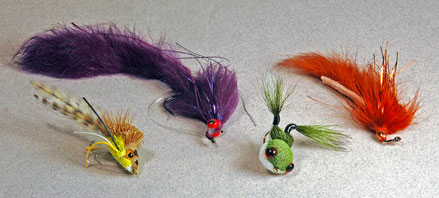 Four fine flies for bass fishing in deep cover, tied by Skip. From left to right:
Four fine flies for bass fishing in deep cover, tied by Skip. From left to right:
Dahlberg Diver in frog colors, Foamtail Super Worm, Messinger Bucktail Frog, Meat Whistle.
Trout vs. Bass: Setting the Hook
Setting the hook on a largemouth, especially with a snag-guard fly, has nothing to do with the trout-fisher’s light tugs—you drop the rod tip, lean back a little—smack the hook home.
But there’s a little more to it than that.
If your fly is hard, such as a cork popper, your time to strike is short—the bass will expel the rigid little imposter in a blink. If your bug is foam or, better yet, packed hair, the bass may chew on it for several seconds, giving you plenty of time to set the hook (though I wouldn’t advise dawdling).
Slack in the line can kill your hook-set—you waste most of your rod-swing just taking out that slack.
So as you drop the rod’s tip, draw in all the line you can without putting any pressure on the fly—even the slightest pull will tell the bass to let go.
Once the extra line between you and the fish is in,
slam that snag-guard fly home.
Make sure you really clamp down with your line-hand too—if the line slips, the set weakens.
Fishing for Bass Back in the Salad:
The Right Tackle Counts
Regarding largemouth-bass tippets and leaders: go stout. I never go under 3X tippet for largemouth anyway, but with snag guards and any chance of hooking a bass over about two-and-a-half pounds I don’t go under 2X, and 1X or even 0X are on the table.
Heavy tippets are for more than smacking home snag-guard flies—you may be dragging a five-pound largemouth—vexed and violent—quickly out of crowded lily pads—imagine the strain that puts on a tippet .
Regarding lines, those nose-heavy bass-bug tapers offer advantages with the big and sometimes wind-resistant flies bass love. With small bass, a six-weight can serve, but a seven-weight is better. For big bass an eight-weight line may be best.
Rods for bass, especially bass in thick cover, need power. Of course power in a rod is largely about line weight; a rod that can shoot out a seven- or eight-weight line must possess good power, making it suitable for casting big flies and the general mayhem of a bass’s muscular fight.
So the only point I’ll make here is that while powerful rods are best for largemouth bass in general, power becomes even more important when they’re rods for snag-guard flies and heavy cover.
Playing those Deep-Undercover Bass
If your idea of playing a fish is coaxing in a brown trout on 6X tippet in the open water of a stony river, please abandon that notion—this is bass fishing.
The moment when you set the hook, you have the element of surprise on your side...briefly. Use that second to your advantage—pull hard, immediately. Try to drag the bass as far as you can before it can react. With luck, you’ll get the fish clear of trouble before it explodes. Typically, you’ll get the fish halfway out of trouble before it explodes—but halfway can help a lot.
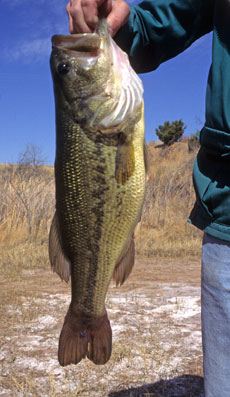 Skip, fishing on foot, hooked this big largemouth bass
Skip, fishing on foot, hooked this big largemouth bass
back in the vegetation of a Texas pond. The fish was
raised briefly for photos and then released.
With weed beds in particular, the trick is to get the bass’s head up out of water and keep it up; this allows you to slide the bass quickly in across the top of the weeds and makes it difficult for him to do much of anything except thrash.
Holding the rod high and maintaining serious pressure on the fish are critical here.
All in all, you’ll need some serious reschooling if you’re a trout fisher taking up largemouth bass— especially largemouth bass back
in the salad.
But it’s an education filled with intriguing challenge and plain fun.
Click here to hear Skip's interviews on popular podcasts...
*Announcements*
Skip has an essay in Big Sky Journal's annual Fly Fishing issue, called "Montana Hoppers: the Princess and the Brute" released February 1, 2023. Skip rewrote it a bit; I painted and illustrated it here, on our website. Here's the link on our web page to check it out:
Click here to read Skip's essay Montana Hoppers: The Princess and the Brute...
Skip's latest books:
Top 12 Dry Flies for Trout Streams: How, When, and Where to Fish Them, is now available on Amazon as an ebook...check it out! Click on the links below to go to the information page on Top 12 Dry Flies (the link to Amazon is at the bottom of the page...)
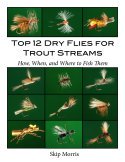 Top 12 Dry Flies for Trout Streams: How, When, and Where to Fish Them
Top 12 Dry Flies for Trout Streams: How, When, and Where to Fish Them
Click here to get more information about
Top 12 Dry Flies for Trout Streams: How, When, and Where to Fish Them (the link to Amazon is at the bottom of the page)...
Top 12 Dry Flies for Trout Streams: How, When, and Where to Fish Them (the link to Amazon is at the bottom of the page)...
Top 12 Nymphs for Trout Streams: How, When, and Where to Fish Them, 2nd Edition, originally published as an e-book only, is now available on Amazon as a paperback...check it out! Click on the links below to go to the information page on Top 12 Nymphs (the link to Amazon is at the bottom of the page...)
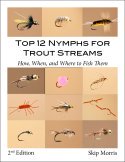 Top 12 Nymphs for Trout Streams: How, When, and Where to Fish Them (2nd Edition)
Top 12 Nymphs for Trout Streams: How, When, and Where to Fish Them (2nd Edition)
Click here to get more information about
Top 12 Nymphs for Trout Streams: How, When, and Where to Fish Them (2nd Edition). . .
Top 12 Nymphs for Trout Streams: How, When, and Where to Fish Them (2nd Edition). . .
Click here to get more information about Skip's e-book,
500 Trout Streams...
500 Trout Streams...
Skip's latest paperback book:
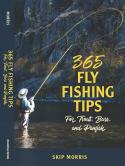 365 Fly Fishing Tips for Trout, Bass, and Panfish
365 Fly Fishing Tips for Trout, Bass, and Panfish
Click here to get more information about Skip's latest book,
365 Tips for Trout, Bass, and Panfish...
365 Tips for Trout, Bass, and Panfish...
Print Skip's chart for FREE:
Skip Morris's Trout-Fly Proportion Chart
Go to Skip Morris's Trout Fly Proportion Chart
Skip's Predator is available to buy...
Skip's ultra-popular Predator—a hit fly for bluegills and other panfishes and largemouth bass (also catches smallmouth bass and trout)—is being tied commercially by the Solitude Fly Company.
The Predator
CLICK HERE to learn more about or to purchase the Predator...
Learn to Tie Skip's Predator
Do you want to tie the Predator?
Tying the Predator
Skip shows you how to tie it on his YouTube Channel link, listed below:
CLICK HERE to see Skip's detailed video on how to tie the Predator...






